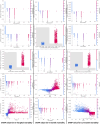Acute myocardial infarction prognosis prediction with reliable and interpretable artificial intelligence system
- PMID: 38804963
- PMCID: PMC11187491
- DOI: 10.1093/jamia/ocae114
Acute myocardial infarction prognosis prediction with reliable and interpretable artificial intelligence system
Abstract
Objective: Predicting mortality after acute myocardial infarction (AMI) is crucial for timely prescription and treatment of AMI patients, but there are no appropriate AI systems for clinicians. Our primary goal is to develop a reliable and interpretable AI system and provide some valuable insights regarding short, and long-term mortality.
Materials and methods: We propose the RIAS framework, an end-to-end framework that is designed with reliability and interpretability at its core and automatically optimizes the given model. Using RIAS, clinicians get accurate and reliable predictions which can be used as likelihood, with global and local explanations, and "what if" scenarios to achieve desired outcomes as well.
Results: We apply RIAS to AMI prognosis prediction data which comes from the Korean Acute Myocardial Infarction Registry. We compared FT-Transformer with XGBoost and MLP and found that FT-Transformer has superiority in sensitivity and comparable performance in AUROC and F1 score to XGBoost. Furthermore, RIAS reveals the significance of statin-based medications, beta-blockers, and age on mortality regardless of time period. Lastly, we showcase reliable and interpretable results of RIAS with local explanations and counterfactual examples for several realistic scenarios.
Discussion: RIAS addresses the "black-box" issue in AI by providing both global and local explanations based on SHAP values and reliable predictions, interpretable as actual likelihoods. The system's "what if" counterfactual explanations enable clinicians to simulate patient-specific scenarios under various conditions, enhancing its practical utility.
Conclusion: The proposed framework provides reliable and interpretable predictions along with counterfactual examples.
Keywords: acute myocardial infarction; counterfactual explanation; electronic health records (EHR); explainable artificial intelligence (XAI); interpretable machine learning.
© The Author(s) 2024. Published by Oxford University Press on behalf of the American Medical Informatics Association.
Conflict of interest statement
None declared.
Figures





Similar articles
-
Interpretable artificial intelligence model for predicting heart failure severity after acute myocardial infarction.BMC Cardiovasc Disord. 2025 May 12;25(1):362. doi: 10.1186/s12872-025-04818-1. BMC Cardiovasc Disord. 2025. PMID: 40355836 Free PMC article.
-
DeepXplainer: An interpretable deep learning based approach for lung cancer detection using explainable artificial intelligence.Comput Methods Programs Biomed. 2024 Jan;243:107879. doi: 10.1016/j.cmpb.2023.107879. Epub 2023 Oct 24. Comput Methods Programs Biomed. 2024. PMID: 37897989
-
Responsible AI for cardiovascular disease detection: Towards a privacy-preserving and interpretable model.Comput Methods Programs Biomed. 2024 Sep;254:108289. doi: 10.1016/j.cmpb.2024.108289. Epub 2024 Jun 17. Comput Methods Programs Biomed. 2024. PMID: 38905988
-
The scientific achievements of the decades in Korean Acute Myocardial Infarction Registry.Korean J Intern Med. 2014 Nov;29(6):703-12. doi: 10.3904/kjim.2014.29.6.703. Epub 2014 Oct 31. Korean J Intern Med. 2014. PMID: 25378967 Free PMC article. Review.
-
Current status of acute myocardial infarction in Korea.Korean J Intern Med. 2019 Jan;34(1):1-10. doi: 10.3904/kjim.2018.381. Epub 2018 Dec 28. Korean J Intern Med. 2019. PMID: 30612415 Free PMC article. Review.
Cited by
-
A Multitask Deep Learning Model for Predicting Myocardial Infarction Complications.Bioengineering (Basel). 2025 May 14;12(5):520. doi: 10.3390/bioengineering12050520. Bioengineering (Basel). 2025. PMID: 40428139 Free PMC article.
-
Explainable illicit drug abuse prediction using hematological differences.Sci Rep. 2025 Aug 7;15(1):28892. doi: 10.1038/s41598-025-06154-y. Sci Rep. 2025. PMID: 40775225 Free PMC article.
-
Critical appraisal and assessment of bias among studies evaluating risk prediction models for in-hospital and 30-day mortality after percutaneous coronary intervention: a systematic review.BMJ Open. 2024 Jul 1;14(6):e085930. doi: 10.1136/bmjopen-2024-085930. BMJ Open. 2024. PMID: 38951013 Free PMC article.
-
Revolutionizing Molecular Design for Innovative Therapeutic Applications through Artificial Intelligence.Molecules. 2024 Sep 29;29(19):4626. doi: 10.3390/molecules29194626. Molecules. 2024. PMID: 39407556 Free PMC article. Review.
References
-
- Tsao CW, Aday AW, Almarzooq ZI, et al.; American Heart Association Council on Epidemiology and Prevention Statistics Committee and Stroke Statistics Subcommittee. Heart disease and stroke statistics—2023 update: a report from the American Heart Association. Circulation. 2023;147(8):e93-e621. - PubMed
-
- Antman EM, Cohen M, Bernink PJLM, et al. The TIMI risk score for unstable angina/non-ST elevation MI: a method for prognostication and therapeutic decision making. JAMA. 2000;284(7):835-842. - PubMed
-
- Morrow DA, Antman EM, Charlesworth A, et al. TIMI risk score for ST-elevation myocardial infarction: a convenient, bedside. clinical score for risk assessment at presentation: an intravenous nPA for treatment of infarcting myocardium early II trial substudy. Circulation. 2000;102(17):2031-2037. - PubMed
-
- Abu-Assi E, Garćıa-Acũna JM, Peña-Gil C, et al. Validation of the GRACE risk score for predicting death within 6 months of follow-up in a contemporary cohort of patients with acute coronary syndrome. Rev Esp Cardiol. 2010;63(6):640-648. - PubMed
MeSH terms
Grants and funding
LinkOut - more resources
Full Text Sources
Other Literature Sources
Medical

